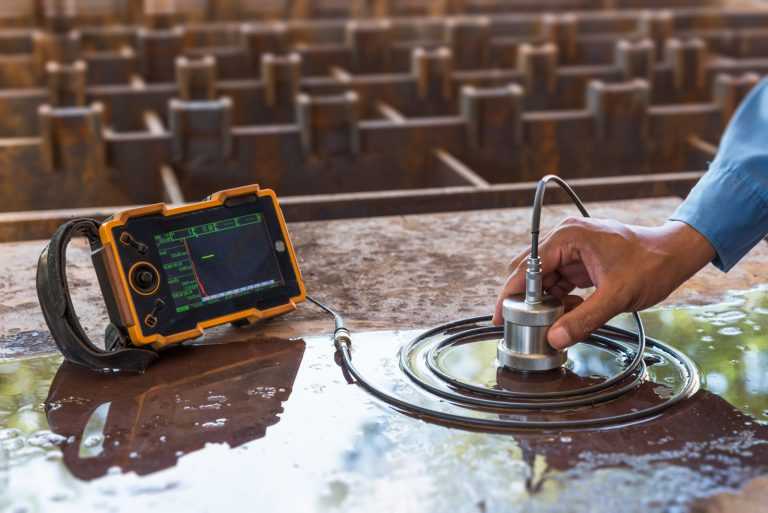

Ultrasonic testing is a non-destructive method used to detect flaws and anomalies in materials, components, and assemblies. It is an advanced technology that has become integral to aircraft maintenance and inspection. Ultrasonic test equipment detects defects and flaws in aircraft components and materials that cannot be identified by visual or manual inspection. In this article, we will discuss the benefits of using ultrasonic testing equipment in aircraft maintenance, the process of ultrasonic testing, and the challenges of using ultrasonic testing in aviation.
Ultrasonic testing uses sound waves to detect flaws and anomalies in materials, components, and assemblies. It is a highly accurate and reliable testing technique for detecting internal and surface defects in materials and parts. Ultrasonic testing is used in various industries, including aviation, automotive, and medical.
Ultrasonic testing is conducted using ultrasonic test equipment comprising an ultrasonic transducer and a controller. The transducer sends and receives ultrasonic waves which travel through the material under test. The controller then analyzes the waves to detect any flaws or anomalies in the material.
The ultrasonic testing process involves using specialized ultrasonic test equipment - an ultrasonic transducer and a controller. The transducer sends and receives ultrasonic waves which travel through the material under test. The controller then analyzes the waves to detect any flaws or anomalies in the material.
The ultrasonic test equipment is connected to the evaluated material or component, and the technician sets the parameters for the test. The parameters are usually selected based on the type of material or component being tested. The transducer then sends and receives ultrasonic waves, and the controller processes the signals to detect any flaws or anomalies.
Once the testing is complete, the technician can analyze the data and determine whether the ultrasonic test equipment has detected any irregularities.
There are various types of ultrasonic testing for aircraft maintenance. The type of ultrasonic testing depends on the aircraft, the material being tested, and the accuracy required. Some of the most commonly used ultrasonic testing techniques for aircraft maintenance are pulse-echo testing, through-transmission testing, and phased array testing.
Pulse-echo testing involves sending an ultrasonic pulse into the material and measuring the reflection of the pulse as it bounces off a reflective surface. Through-transmission testing consists of sending an ultrasonic vibration through the material and measuring the signal that is transmitted through the material. Phased array testing is a more advanced technique that uses multiple ultrasonic transducers to measure the sound waves as they travel through the material.
Ultrasonic testing is a very versatile technique and can be used to detect a wide variety of defects and flaws in aircraft components and materials - making it an ideal method for aircraft maintenance and inspection. Ultrasonic testing can also uncover weaknesses in hard-to-reach areas that would be difficult to inspect manually.
Another benefit of ultrasonic testing is that it is a non-destructive testing technique, which means that the material or component being tested does not have to be damaged or destroyed to be tested. This makes it an ideal method for aircraft maintenance as it does not require any components or materials to be replaced or repaired.
Although ultrasonic testing is an advanced technology that has become an integral part of aircraft maintenance and inspection, some challenges are associated with using ultrasonic testing in aircraft maintenance. One of the main challenges is that ultrasonic testing is a complex process that requires specialized knowledge and skills to be performed correctly.
In addition, ultrasonic test equipment is expensive and requires regular maintenance and calibration to ensure accuracy. This means that aircraft maintenance personnel must be properly trained and certified to operate and maintain the ultrasonic test equipment.
Finally, ultrasonic testing is limited in detecting certain flaws and defects. Therefore, it is vital to use other testing methods in conjunction with ultrasonic testing to ensure the safety and reliability of aircraft components and materials.
Ultrasonic testing is an advanced technology that has become integral to aircraft maintenance and inspection. The benefits of using ultrasonic test equipment in aircraft maintenance include its accuracy, reliability, versatility, and non-destructive nature. However, there are some challenges associated with using ultrasonic testing in aircraft maintenance, such as the process's complexity, the equipment's cost, and its limited ability to detect certain types of flaws and defects.
Despite the challenges, ultrasonic testing is an invaluable tool for aircraft maintenance and inspection. It is a highly accurate and reliable method of detecting issues in aircraft components and materials that are hard to identify by visual or manual inspection.
Affiliate Partner Program | Jobs at Spartan | Privacy Policy | Opt-out Policy | Privacy Notice - California Residents| Notice of Non-Discrimination | Website Accessibility Help | Transparency in Coverage Act
© 2024 SPARTAN COLLEGE OF AERONAUTICS AND TECHNOLOGY. ALL RIGHTS RESERVED.